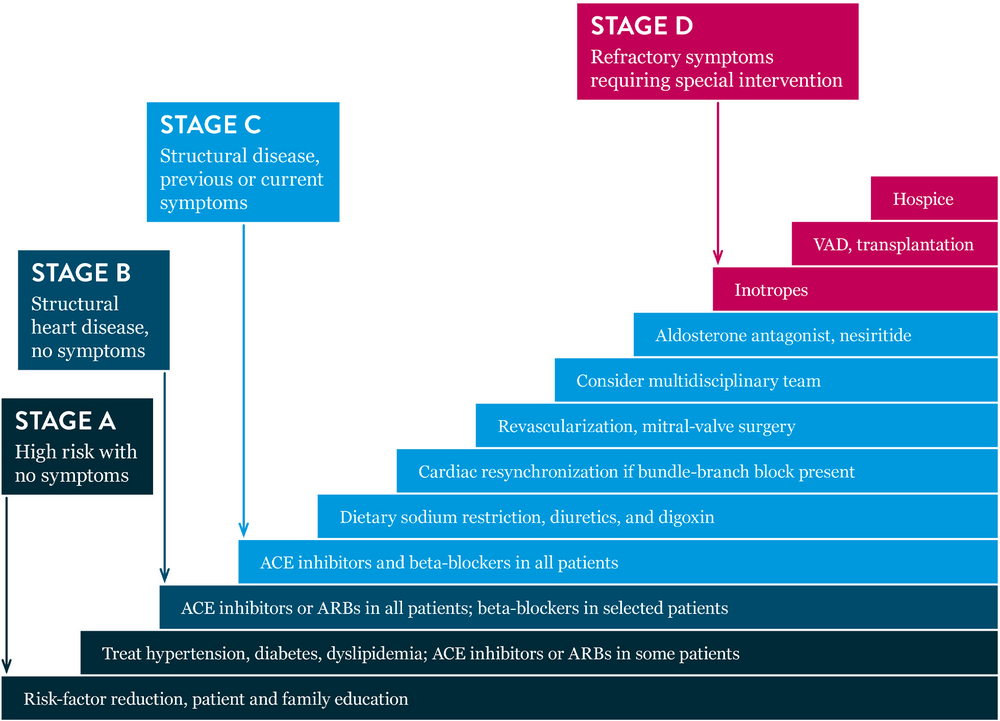HEART FAILURE MANAGEMENT OPTIONS
Management options for heart failure may include a combination of lifestyle changes, medications, implantable devices such as a pacemaker or defibrillator providing cardiac resynchronisation therapy (CRT) and at a later stage a left ventricular assist system (LVAS), and transplant. The following figure shows the stepwise up titration of therapies when patients progress to advanced stages of heart failure.
FIND OUT MORE ABOUT:

Patients may also receive a remote monitoring system which allows them to transmit data to the doctor without an in-office visit.
HF MONITORING
A pulmonary artery (PA) pressure monitoring system lets you proactively monitor PA pressure, potentially providing early indication of worsening heart failure. Physicians using a PA pressure monitoring system to monitor their patients—in conjunction with guideline-directed medical therapy—have seen a reduction in heart failure hospitalizations and readmissions, as well as an improved quality of life.2-4
Heart failure medications may be prescribed to treat all stages of heart failure. Medications become less effective at treating heart failure symptoms as the disease progresses.
The New York Heart Association (NYHA) classifies the stages of heart failure as follows.5 The chart below shows some of the devices that may be recommended by a doctor at different stages of heart failure:
FIND OUT MORE ABOUT:
CLASS I
No limitation of physical activity. Ordinary physical activity does not cause undue fatigue, palpitation, dyspnea (shortness of breath).
CLASS II
Slight limitation of physical activity. Comfortable at rest. Ordinary physical activity results in fatigue, palpitation, dyspnea (shortness of breath).
CLASS III
Marked limitation of physical activity. Comfortable at rest. Less than ordinary activity causes fatigue, palpitation or dyspnea.
CLASS IV
Unable to carry on any physical activity without discomfort. Symptoms of heart failure at rest. If any physical activity is undertaken, discomfort increases.

CLASS II + CLASS III
MITRACLIP™
MitraClip™ is a percutaneous therapeutic option which provides a solution for patients with moderate to severe degenerative mitral regurgitation (DMR) or functional mitral regurgitation (FMR) who are not considered suitable candidates for conventional mitral valve surgery.

CLASS III
CARDIOMEMS™ HF SYSTEM
The CardioMEMSTM HF System features a small pressure sensing device that is implanted directly into the pulmonary artery. It sends information wirelessly from the patient to the doctor who can use that information to adjust the medication and treatment plan, if needed.

CLASS IIIB + CLASS IV
HEARTMATE 3™ LVAD
A left ventricular assist device (LVAD) is intended for a broad range of advanced heart failure patients and is designed to restore blood flow which can improve survival, functional status and quality of life. It is an option for patients with NYHA Class IIIB or IV heart failure. It can be used for both short-term and long-term heart support, such as Bridge To Transplantation and Destination Therapy.
TV
TV
HUB
- Jessup M, Brozena S. Heart Failure. N Engl J Med. 2003;348(20):2007–2018. doi.org/10.1056/NEJMra021498.
- Abraham WT, Adamson PB, Bourge RC, et al. Wireless pulmonary artery haemodynamic monitoring in chronic heart failure: a randomised controlled trial. Lancet. 2011;377(9766), 658–666. doi.org/10.1016/S0140-6736(11)60101-3.
- Abraham WT, Stevenson LW, Bourge RC, et al. Sustained efficacy of pulmonary artery pressure to guide adjustment of chronic heart failure therapy: complete follow-up results from the CHAMPION randomized trial. Lancet. 2016;387(10017):453–461. doi.org/10.1016/S0140-6736(15)00723-0.
- Adamson PB, Abraham WT, Bourge RC, et al. Wireless pulmonary artery pressure monitoring guides management to reduce decompensation in heart failure with preserved ejection fraction. Circ Heart Fail. 2014;7(6), 935–944. doi.org/10.1161/CIRCHEARTFAILURE.113.001229.
- www.heart.org/en/health-topics/heart-failure/what-is-heart-failure/classes-of-heart-failure. Accessed July 2023.